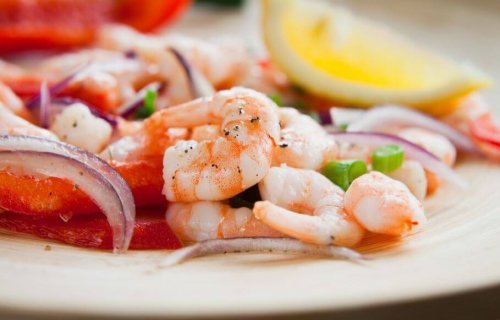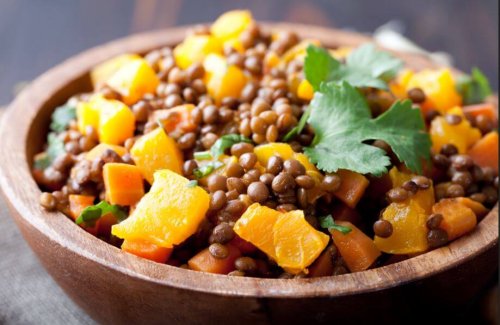Foods Rich in Iron

Iron is a very important mineral that’s essential for the correct development, growth, and functioning of our bodies. It performs significant actions, such as producing hemoglobin and myoglobin—proteins that transport oxygen to different organs through the blood. Moreover, it participates in the process of hormone production and tissue creation.
Iron is found in many of the foods that we consume—both of animal and vegetable origin. However, there are two types of this mineral that the body doesn’t absorb in the same way. Heme iron is found in meat and a quarter of it is absorbed by the body. We only make use of 10 percent of the non-heme iron that’s present in vegetables.

It’s important to know which foods have a high content of iron, but it’s also beneficial to know which substances help us absorb and effectively use this mineral, such as vitamin C and other acids. Eating a diverse and balanced diet covers the daily needs of iron and other substances. The following foods contain iron:
Foods of animal origin
Most products of animal origin have high iron content. Furthermore, the body is able to absorb a larger amount since its heme iron. Even so, excessive consumption of foods rich in iron can cause a negative effect on our bodies. Due to this, it’s recommendable to have a varied diet including all kinds of food and not only iron-rich ones.
Fish and seafood
- Clams and cockles: contain 24mg of iron per 100g.
- Mussels: they have 4.5mg per 100g.
- Sardines: provide 3.2 mg per 100g.
- Prawns: they have 1.9 mg. It’s necessary to control their consumption in order to avoid raising uric acid levels.

Meats
- Liver: has 8mg of iron and also contain folic acid and vitamin B12.
- Partridge and quail: they have 7.7mg per 100g.
- Kidneys: contain 5.7mg.
- Beef: the amount of iron in beef is greater than that of white meat since it offers 2.5mg per 100g.
- Pork: doesn’t contain as much of this mineral as other meats (1.5mg). Although, it does contain sodium, potassium, phosphorus, and zinc.
Eggs
Iron is mainly found in egg yolks. Two chicken eggs provide about 2.2mg per 100g.
Foods of vegetable origin
Although the iron found in these foods is more difficult to absorb, these products contain other substances and elements that are essential for the proper functioning of our bodies. That’s why it’s advisable to consume products rich in vitamin C, such as citrus fruits that enhance the absorption of this mineral.
Vegetables and legumes
- Spinach: contains 4mg of iron per 100g. Furthermore, it’s rich in vitamin A and is an important source of fiber.
- Swiss chard: they have 3.1 mg per 100g.
- Beans: provide 8.5 mg per 100g. They also offer vitamins such as B1 or niacin and other minerals such as manganese, copper, calcium, and phosphorus.
- Lentils: they have 7.1 mg per 100g and have very little fat while containing high amounts of fiber and carbohydrates as well.
- Chickpeas: they provide 6.7 mg per 100g.

Nuts
- Pistachios: they offer 7.3mg of iron per 100g. Additionally, they contain lots of fiber and energy.
- Almonds and hazelnuts: provide 4.2 mg per 100g and have many proteins and complex carbohydrates.
- Walnuts, peanuts, and dates: they have about 2 mg per 100g.
Iron in whole grains
Whole wheat bread and crackers contain about 2mg of iron per 100g and they are also a very important source of fiber and carbohydrates. Moreover, these foods are commonly eaten at breakfast, so accompanying them with orange juice that’s rich in vitamin C can help absorb the iron in these products.
In conclusion, we’ve seen that most foods contain iron, both of animal and vegetable origin. However, following a varied and balanced diet is the best option to maintain the optimum levels of this mineral.
Iron is a very important mineral that’s essential for the correct development, growth, and functioning of our bodies. It performs significant actions, such as producing hemoglobin and myoglobin—proteins that transport oxygen to different organs through the blood. Moreover, it participates in the process of hormone production and tissue creation.
Iron is found in many of the foods that we consume—both of animal and vegetable origin. However, there are two types of this mineral that the body doesn’t absorb in the same way. Heme iron is found in meat and a quarter of it is absorbed by the body. We only make use of 10 percent of the non-heme iron that’s present in vegetables.

It’s important to know which foods have a high content of iron, but it’s also beneficial to know which substances help us absorb and effectively use this mineral, such as vitamin C and other acids. Eating a diverse and balanced diet covers the daily needs of iron and other substances. The following foods contain iron:
Foods of animal origin
Most products of animal origin have high iron content. Furthermore, the body is able to absorb a larger amount since its heme iron. Even so, excessive consumption of foods rich in iron can cause a negative effect on our bodies. Due to this, it’s recommendable to have a varied diet including all kinds of food and not only iron-rich ones.
Fish and seafood
- Clams and cockles: contain 24mg of iron per 100g.
- Mussels: they have 4.5mg per 100g.
- Sardines: provide 3.2 mg per 100g.
- Prawns: they have 1.9 mg. It’s necessary to control their consumption in order to avoid raising uric acid levels.

Meats
- Liver: has 8mg of iron and also contain folic acid and vitamin B12.
- Partridge and quail: they have 7.7mg per 100g.
- Kidneys: contain 5.7mg.
- Beef: the amount of iron in beef is greater than that of white meat since it offers 2.5mg per 100g.
- Pork: doesn’t contain as much of this mineral as other meats (1.5mg). Although, it does contain sodium, potassium, phosphorus, and zinc.
Eggs
Iron is mainly found in egg yolks. Two chicken eggs provide about 2.2mg per 100g.
Foods of vegetable origin
Although the iron found in these foods is more difficult to absorb, these products contain other substances and elements that are essential for the proper functioning of our bodies. That’s why it’s advisable to consume products rich in vitamin C, such as citrus fruits that enhance the absorption of this mineral.
Vegetables and legumes
- Spinach: contains 4mg of iron per 100g. Furthermore, it’s rich in vitamin A and is an important source of fiber.
- Swiss chard: they have 3.1 mg per 100g.
- Beans: provide 8.5 mg per 100g. They also offer vitamins such as B1 or niacin and other minerals such as manganese, copper, calcium, and phosphorus.
- Lentils: they have 7.1 mg per 100g and have very little fat while containing high amounts of fiber and carbohydrates as well.
- Chickpeas: they provide 6.7 mg per 100g.

Nuts
- Pistachios: they offer 7.3mg of iron per 100g. Additionally, they contain lots of fiber and energy.
- Almonds and hazelnuts: provide 4.2 mg per 100g and have many proteins and complex carbohydrates.
- Walnuts, peanuts, and dates: they have about 2 mg per 100g.
Iron in whole grains
Whole wheat bread and crackers contain about 2mg of iron per 100g and they are also a very important source of fiber and carbohydrates. Moreover, these foods are commonly eaten at breakfast, so accompanying them with orange juice that’s rich in vitamin C can help absorb the iron in these products.
In conclusion, we’ve seen that most foods contain iron, both of animal and vegetable origin. However, following a varied and balanced diet is the best option to maintain the optimum levels of this mineral.
This text is provided for informational purposes only and does not replace consultation with a professional. If in doubt, consult your specialist.








